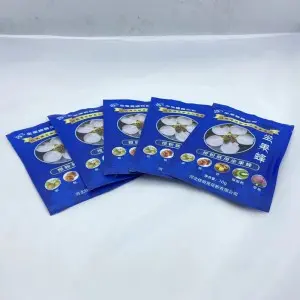Oct . 21, 2025 12:35 Back to list
Pollen Peach Tree: Premium Peach Pollen for Pure Pollination
The Quiet Economics of Peach Pollination: why premium pollen still pays
If you manage an orchard, you already juggle bloom windows, weather, and bees that sometimes don’t read the memo. That’s exactly why growers keep asking me about Pollen Peach Tree solutions—specifically, high‑purity peach flower powder used for cross‑pollination. To be honest, I was skeptical years ago. Now, after walking blocks from Hebei to Yakima, the data (and the fruit bins) keep nudging me in the same direction.

Industry trend, quick take
Even self‑fertile peach cultivars often set better with assisted, targeted cross‑pollination—especially in cool bloom seasons, or when bee hours drop. The trend is pragmatic: precision pollination with lab‑verified pollen, applied at 10–30% and again at 60–80% bloom. Climate variability is pushing this from “nice to have” to a line item that returns real money.
Product snapshot
Pollen Peach Tree supply from Caozhuang Development Zone, Fanzhuang Town, Zhao County, Shijiazhuang, Hebei Province, arrives cleaned, sieved, viability‑tested, and cold‑chain protected. Below are the specs people ask me for first.
| Spec | PEACH FLOWER POWDER SUITABLE FOR PEACH POLLINATION |
|---|---|
| Origin | Caozhuang Dev. Zone, Zhao County, Shijiazhuang, Hebei |
| Pollen purity | ≈95–98% (real‑world may vary by lot) |
| Moisture | ≤6% (Karl Fischer) |
| Viability (FDA/TTC) | ≈85–92% at dispatch |
| In‑vitro germination (BK medium) | ≥75% typical |
| Particle size | 80–120 mesh |
| Storage & service life | −18 to −25°C up to 12 months; 0–4°C ≈7–10 days; |
| Packs | 50 g / 100 g vials, nitrogen‑flushed |
| Application | ≈80–120 g/ha; 10–30% + 60–80% bloom; with talc/lycopodium carrier 5:1 |
How it’s made (short version)
Selected donor cultivars → hand collection → low‑temp drying (≈32–34°C) → de‑anthering and multi‑stage sieving → optical cleaning → composite blending (when specified) → QC (FDA/FDA, TTC, BK medium germination, microbial) → vialing under inert gas → frozen logistics. Testing references include FDA/FDA fluorescence for viability and Brewbaker & Kwack medium for germination. Simple, meticulous, a bit nerdy.
Use cases, advantages
- Cool bloom, low bee flight, wind‑exposed blocks.
- High‑density orchards needing uniform set and tighter fruit size bands.
- Targeted cross‑pollination to lift marketable grade—many customers say they notice pack‑out first.
In company trials comparing natural pollination versus artificial cross‑pollination, high‑quality commercial fruit share rose from 60% to 75%, and total yield improved ≈30%. That squares with what I’ve seen in field notes, surprisingly consistent across seasons.
Vendor comparison (what buyers actually check)
| Criteria | JML Pollen (Hebei) | Supplier A | Supplier B |
|---|---|---|---|
| Viability at ship | ≈85–92% | ≈75–85% | varies; data on request |
| Cold chain | Frozen, insulated, data‑logged | Refrigerated | Mixed |
| Customization | Blend by cultivar/Brix, mesh options | Limited | Limited |
| Docs | COA, phytosanitary, test sheets | COA only | On request |
| Price (100 g) | ≈$75–$110 | ≈$60–$95 | ≈$55–$90 |
Customization, quick notes
Some blocks want donor pollen from complementary bloom timing; others ask for blends aligned with orchard Brix targets. Application can be done with electrostatic wands or air‑blast rigs—mix with a neutral carrier. As always, keep Pollen Peach Tree vials cold; decant small amounts to avoid condensation.
Quality & compliance
Routine tests include FDA fluorescence, TTC, BK medium germination, and microbial counts; COA and phytosanitary certificates ship with lots. Ask vendors for QMS details (ISO 9001‑style controls are common). One client told me, “We thought it was an extra cost. It ended up being our cheapest fruit size upgrade.” I guess that’s the point.
Citations
- FAO. Pollination of Cultivated Plants: A Compendium. Food and Agriculture Organization, 2018.
- Penn State Extension. Pollination in Tree Fruit Orchards, accessed 2025.
- Brewbaker, J.L., and B.H. Kwack. The essential role of calcium ion in pollen germination and pollen tube growth. American Journal of Botany, 1963.
- ISHS Acta Horticulturae. Studies on cross‑pollination effects on Prunus persica fruit set and quality, various volumes.
-
Comprehensive Guide to CE Certification Apricot Pollen Health Benefits
NewsNov.24,2025
-
CE Certification Mango Fruit Protection Bags: Enhancing Export Quality & Sustainability
NewsNov.23,2025
-
CE Certification Varieties Suitable for Collecting Apple Pollen – Ensuring Quality & Compliance in Apple Breeding
NewsNov.22,2025
-
Comprehensive Guide to CE Certification Mango Cover Bags – Quality, Standards & Trends
NewsNov.22,2025
-
What You Need to Know About CE Certification Peach Blossom Powder Keto
NewsNov.21,2025
-
CE Certification Pear Pollen Collection Base – Ensuring Quality & Sustainability in Global Horticulture
NewsNov.20,2025